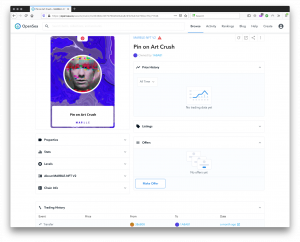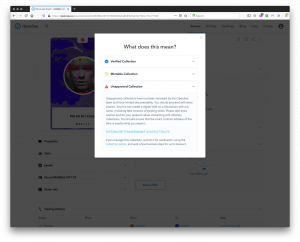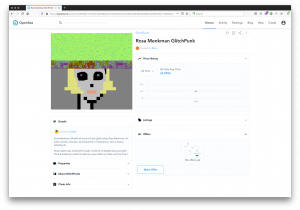A few weeks ago my students and I came to the conclusion that the GameStop short squeeze could be read as just another form of tactical media resistance, organized through Reddit. With tactical media, I of course mean the practice of shorting the one in power (the institution) by creating momentary interventions on their turf (de Certeau). Some of my students concluded that the squeeze was just another whim of the capitalist machine. These new tactical capitalist strategies will not undermine, but rather soon be assimilated by the machine. In any case, we all felt it was nice to see the people in power (short-sellers) sweat for a moment. I can see a romantic appeal here.
On a similar note, we briefly spoke about non-fungible tokens. A colleague of mine, Auriea Harvey, approached me and asked if I were interested in organizing a seminar on NTFs, as they seem to be gaining a lot of traction on social media. I think this is because of a combination of the understanding that digital assets can be worth $ and an influx of new money due to the rise of cryptocurrencies. Up till now, I have actually refused to get into #NFTs, the market and its discussions, because I am concerned about its carbon footprint. And also because I don’t believe that DeFi (Decentralized Finance) as it looks right now, is anywhere near to actually redistributing or democratizing (something I read often but still really cannot take seriously) global finance. DeFi merely redistributes new money to a particular group of the same users. It’s worsening the same old problems. I feel conflicted about it. It is also far from usable for everyone, given that access to the internet is still a real problem in some countries because of both cost and power issues is – just as a reference: Econet subscribers in Zimbabwe pay $13 for a daily 20 megabyte (MB) data bundle, while Zimbabwe is still suffering from rolling black and brownouts daily.
It turns out that even if I don’t take part, the cat is already out of the bag. My art works, or rather, Pinterest pins of my work and fan art about me, are already co-opted and sold as NFTs. I found four works quotes or copies. I’m unsure about what term to use here. One work, which was a piece of fan art that had my name in its title but bared no image of mine, was even residing on the website opensea.io, which is, as it self proclaims “the largest NFT marketplace.” My work and my name have entered the blockchain where they reside indefinitely (because once something is put on the blockchain as NFTs, they remain there).



The four particular works that quoted my images turned out to be marble cards, ‘assets’ created on the marble.cards platform. The site says: “Discover. Create. Collect. Every web page can only be marbled once and by one person only. When you find an article, video or anything else you like that has a URL, you can “marble” it into a crypto collectible card. Marble is based on the ERC721 protocol and every URL can only be marbled once. When you buy a Marble card, it’s yours to save, share or trade.” In other words, the Marble.cards platform tokenizes URLs. When you are the first to tokenize a URL, you own it as a collectible card. These cards can be used to create and share in collections in the Marble community. They become assets that can be traded in and outside of the Marble platform, for instance on opensea.io. And it does not matter who owns the server, the URL or its content—this is a new logic of tokenizing and trading grabs.
From their FAQ: When you find a link you want, you paste it on the platform to see if it’s available for marbling. If it’s available and you want to create the card, you pay the initial auction fee. What happens then is a public Dutch auction is created for that card.
Anyone can see the auction and buy the card. If someone else buys it, you are paid a % in creators fee. If no-one buys it before the auction time runs out you get it. You also have the option to buy it in the auction and get the finder fee as a discount. The current creator reward/discount is 30%.
So much for my active refusal to take part in the NFT debate. Questions about ownership, copyright, monetization, fan art, digital scarcity became important to address. Tactical finance or tokenization is not just a creative resistance against the financial institute – it was now also affecting me, the everyday artist. On a personal note, everything I ever made, whether it is a website or a video, or a 3D work is freely available on the web via <COPY-IT-RIGHT>. Even when it is sold. That is my personal ethos. I believe in knowledge and work distribution. But through these new smart contracts, it seems a new form of digital money alchemy is happening.
It takes more than the past to understand and build the archive. from Rosa Menkman
Back to one point in case: a Pinterest link is showing my portrait, titled “PIN on art crush” available on the opensea.io platform.
A tweet about this got subtweeted, connecting me to the young man behind the platform, Johan Unger, which resulted in an hour-long phone conversation during which I learned some new ins and outs of the crypto scene and tokenizing the web. Here are some takeaways: Unger is convinced that in the coming years and as a result of web 3.0, every digital asset (URL, image, tweet, etc.) will be tokenized via blockchain technologies. He mentioned platforms such as https://v.cent.co/ that tokenize and sell tweets as an example.
In my case, Unger explained that it was someone who liked my image on Pinterest, and as a result had ‘marbled’ that URL. This person created a marble card, which means they tokenized the URL on the blockchain. What is marbled in this case—or hashed onto the blockchain—is just a reference to a URL, and not the preview image which is shown, or represented on the marble card on the opensea.io platform. That is pretty complex since the image—my self-portrait—is in fact actually cropped and shown on top of the card and has as a result become a representation of the newly minted digital asset.
Unger went on to explain to me this technology is nothing new. Something similar happens when we link in a tweet or post a URL on Facebook. When posting a URL it often shows a preview image, which does not mean that posting a URL means you claim the Image on your timeline. It is the platform effect of linking.
Unger also recounted to me the old logic of exposure. A reference or URL to my work brings me exposure. More exposure is generated through ARENAs on the marble platform, where the Marble (the tokenized URL with preview image) gets a place inside a user’s collections and can be traded. Which is good for me and my work. They even want to build an artist support system so that artists can claim a % of the transactions as well. But for now, only the initiator of the auction is paid a share of the cards that they put up for auction.
Unger also told me that the particular cards that featured and linked my images had not been verified on marble.cards. This means they are not actually up for trade on the platform. However, once opensea.io will have integrated the matic blockchain protocol, they will be tradeable just like all the other cards via opensea. Unger closed with the following: “The card with your art is non- verified. Because it has not been verified by the creator, I don’t think anyone will buy it and so it is not worth anything.”
Prominent questions I see here should be formulated around issues of value, authorship, linking (and linked preview content) and authenticity. Value (of an artwork for instance) is not just generated through a marketplace and bidding, or through the tokenizing of a work. Value is also added and generated by the work existing inside various cultural discourses, gaining meaning over time. Besides, these cards are both a representation or a link to an object, and an object in themselves. There is a weird tension between monetizing URLs of particular assets but then the URLs becoming assets themselves. I think these complexities that ascribe value to any token (or tokenized artwork) are under thought on this platform.
As (digital) authenticity becomes more important, this too needs to be reconsidered. If an asset has not one creator, who or how can the content be verified, what makes an asset authentic? Assets often emerge from a culture (for instance, memes, do all memes have authors?) rather than that it is rendered by one author. So how do you verify authenticity? Does verification just depend on an author’s signature (what if they are already dead)? And finally, what is the point of tokenizing an asset on a blockchain if it cannot be verified? Not all content needs to be spread through the network – or on the blockchain.
Tokenizing or marbling a memory of someone else’s work on a carbon-heavy marketplace, just for exposure of their work, isn’t without issues. While all technologies have good and bad effects, the pros & cons don’t play a 0-sum game – they do not outweigh each other. They are separate issues to consider. In the case of the 4 tokenized Marble cards, I agree with Unger in the sense that this is definitely not a straight forward theft of an image or IP—we are entering a far more complex situation in this game of ‘tokenize everything’. In this case, my edited images have become a symbol, or, a linked preview of a tokenized URL linking to my self-portrait. The question then becomes: what constitutes the value of a tradable card? The memory of the one that creates the NFT, the actual linked content, which shows up as my cropped portrait or asset that is being tokenized such as a URL owned by Pinterest?
I have some more questions about the NFT scene. Why do so many of these artworks exist in series? There are, for instance, series of 3D cans with a texture on them, series of portraits, videos of a girl eating different fruits and drawings of a neighborhood using the same exact style and colors. The platform seems to prefer a curation of series or rather stylistic tokenization.
I am also completely missing the discussion of artistic patronage in these marketplace platforms. All of this seems a lot about making money, and not about how art can be supported and better represented.
New technologies such as NFTs can’t be cancelled. Once they exist, they are here to stay. Sadly, the only solution I see is to revive the old discussion about subjects such as the art market and its energy footprint, ownership and authenticity. But this is a formative stage and as such a very important time to have this dialogue, even if we are already sick of it. These new smart contracts make space for reconsideration of old contracts, leveraging new forms of ownership. But for this to grow positively, we need a thoughtful ‘best practice’ implementation that is not just spearheaded on Twitter by artists and curators but adopted, supported and studied by the new platforms and their creators, engineers and users.
In that way, new tactical platforms can actually change the practice of everyday life of the artist and their finance—even if it is just financially.
.-.. . – / – …. . / -… — – … / .-.. — — -.- / — …- . .-. / ..- …
░░░░░░▒▒▓██▓▒▒▒ ▒ ▒ ▒ ▒ ▒
Rosa Menkman
https://beyondresolution.info/


